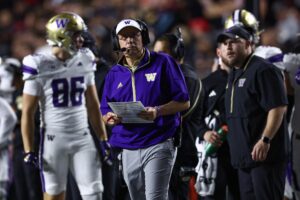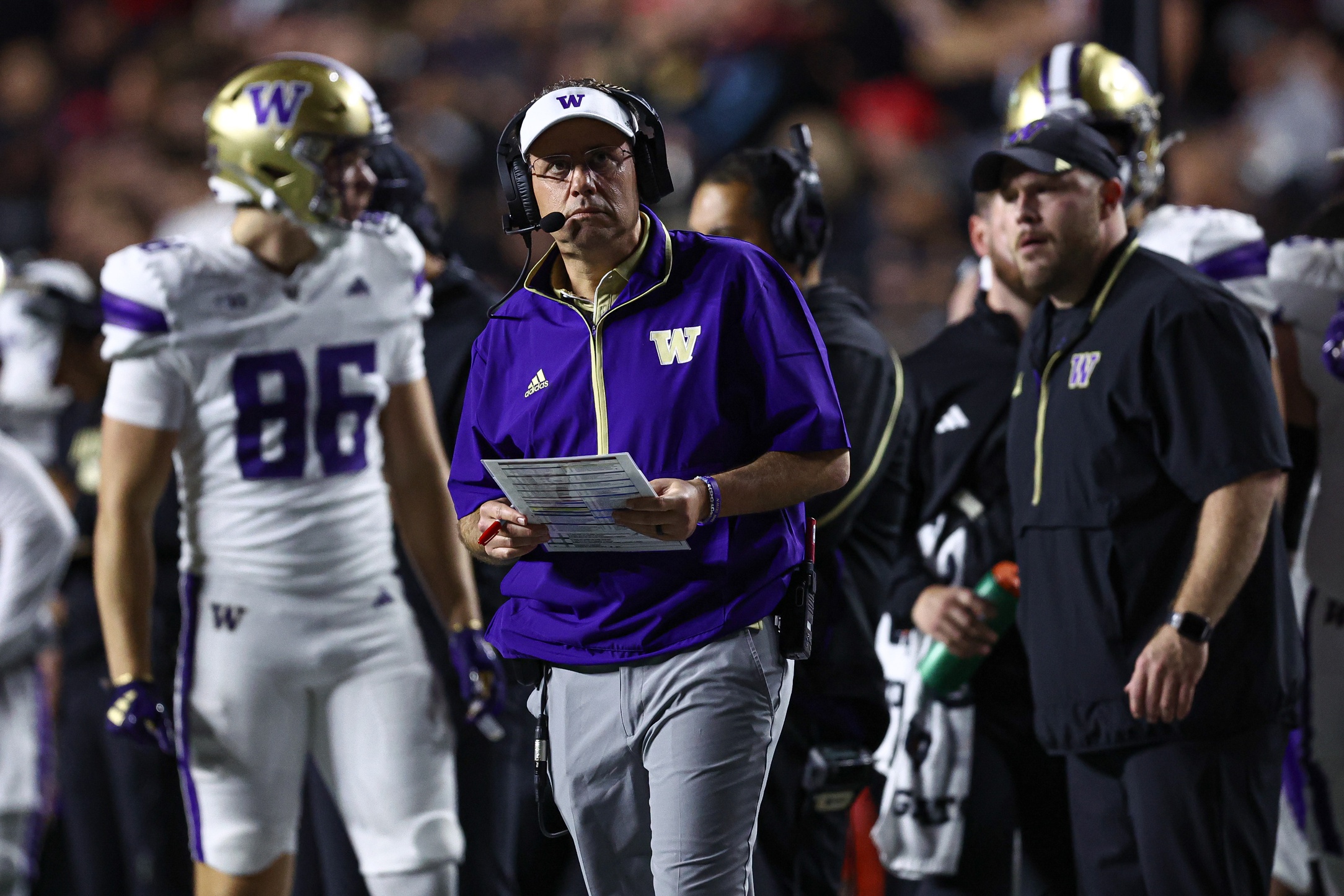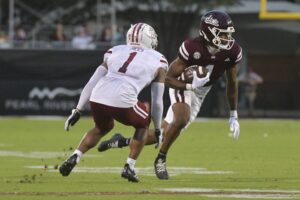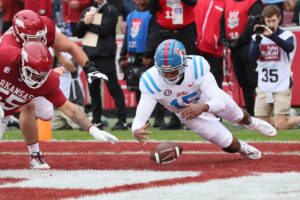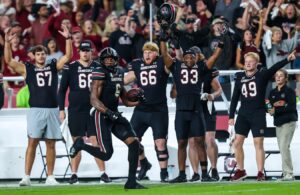“I don’t know if our players understand how hard of a stadium [Kinnick Stadium] is to play in.” Washington head coach Jedd Fisch shared this in July at Big Ten Media Days when asked about his familiarity with the Iowa Hawkeyes. Fisch was the quarterbacks coach for Michigan back in 2016 when he last entered Kinnick Stadium. Then, his second-ranked Wolverine team was upset under the lights by unranked Iowa. Fisch also coached in Iowa City as the offensive coordinator for Minnesota in 2009. That time, it was a shutout loss for the Golden Gophers. On Saturday, Fisch will face Iowa for the third time in his career, and first as the head coach of Washington. “It will be a great challenge, we know that.” For Iowa, it starts with its defense. And this year, its ground game has taken a leap forward with running back Kaleb Johnson.
The Hawkeye Defense
Phil Parker was last year’s Broyles Award winner, given to the nation’s top assistant coach. His defense finished fourth in scoring (14.8 points allowed per game), and seventh in total defense (282.5 yards per game). The success on that end of the ball was a major component of Iowa’s 10-win season despite an offense that finished dead last nationally in total yards (234.6 per game). This season, the Hawkeye defense returned a handful of its top contributors from last year’s unit and remains the team’s strength.
Two-Gap Defensive Front
The Hawkeye defense begins at the defensive line. Iowa typically has four defensive linemen on the field at a time and will run a two-gap scheme up front. As such, its defensive linemen are responsible for two gaps. They use leverage to position themselves in one gap while using the engaged offensive lineman to fill the second gap. This kind of gap scheme requires big, strong, and fundamentally sound defensive linemen.
This starts at the interior, where Iowa has Aaron Graves and Yahya Black. Both defensive tackles are 300-plus pounds and play physical football. Graves and Black have played over 200 snaps this season, averaging around 40 per game. On the outside, Deontae Craig and Ethan Hurkett are responsible for the outside gaps and set the edge. But these players aren’t necessarily the ones tallying the tackles. Their responsibility is gap coverage. In a two-gap scheme, linebackers become much more versatile.
Linebacker Responsibility
With the defensive linemen on gap assignment, linebackers are now able to roam and scrape in the second level of the defense. They can slide up and down the formation and track the run game. In turn, linebackers in this defense make a lot of the tackles in run defense. This creates more tackling responsibility on the linebackers. Again, it’s a position that requires fundamentally sound players.
Linebackers Jay Higgins and Nick Jackson have combined for 115 games played at the college level. Their range and versatility in the middle of the defense create a lot of tackling opportunities, and they do just that. Higgins leads the team with 48 tackles this season. Jackson is second on the team with 28 total. The Hawkeye linebackers are highly involved in run-stopping for this defense that allows just 3.15 yards per rush this season.
Kaleb Johnson
The Hawkeye offense features the top running back in the Big Ten Conference in terms of yardage. Johnson averages nearly eight yards per carry with 771 rushing yards this season. Iowa’s tailback has scored 10 touchdowns on the season and is the workhorse for offensive coordinator Tim Lester’s group.
One of the things that Johnson does so well is create yards after initial contact. 538 of his 771 yards this season have been after contact. On a per-carry basis, Johnson is averaging 5.6 yards after contact. This year, Iowa’s rushing offense ranks 13th nationally. It hasn’t ranked inside the top 100 since the 2020 season. It’s taken a leap forward this season with Lester calling plays. The difference this year has been the installment of the mid-zone run scheme, and it plays directly into Johnson’s abilities as a runner.
Mid Zone Run Scheme
Offensively, Iowa is far from elite. But under Lester, the run game has been the group’s most productive phase. Lester was an offensive analyst for the Green Bay Packers last year and the head coach for Western Michigan before that. A big part of his offense is the mid-zone run scheme. Iowa has always been a program that works to establish the run game and beat its opponents at the line of scrimmage. But this tweak in the run game has helped pave the way for Johnson’s dominant start to the season.
As the name indicates, a mid-zone run scheme is between the inside zone and outside zone. The target point of the running back is the inside leg of the tackle, usually to the play-side (wide side) of the field. This is unlike in outside zone, where the target point is the outside leg of the “ghost” tight end. Mid zone allows the blockers to engage quicker, giving the running back an opportunity to reach the second level more efficiently.
Fitting Kaleb Johnson’s Skillset
As far as blocking, the linemen’s path is more “upfield” than in an outside zone. Rather than stretching laterally to engage in outside zone blocks, the linemen’s blocks work towards the second level of the defense. As such, mid-zone creates an opportunity for linemen to engage in linebackers that aren’t stretching laterally to defend an outside-zone run. This run scheme is a faster-developing play, and it gives the tailback more of a direct path through the formation. What it requires is a runner with good vision, adequate speed, and oftentimes the ability to break tackles and run physically.
This is Johnson’s skill set. We’ve seen his vision on display all season, finding the open lanes and making the right directional decisions. With a mid zone, Johnson also hits the formation with more force than in a slower-developing outside zone scheme. Once there, his offensive linemen have already engaged with the linebackers. Then it’s Johnson’s speed that allows him to break away from that second level.
Iowa’s tailback is sixth nationally with 20 runs of 10-plus yards. Directionally, Johnson has been at his best to the right side of the field running towards the inside leg of the tackle. There, he has 333 yards, four touchdowns, and 7.4 yards after contact. Johnson is finding the hole quickly, and using his speed and tackle-breaking abilities to generate chunk plays. The Hawkeye offense ranks 13th nationally in rushing, and that’s due to what Johnson has been able to do in this mid-zone run scheme.
